Winner Medals
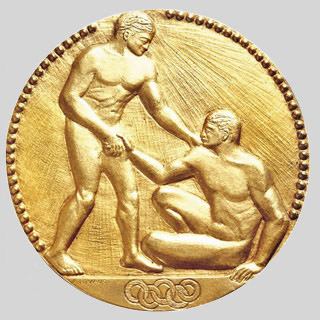
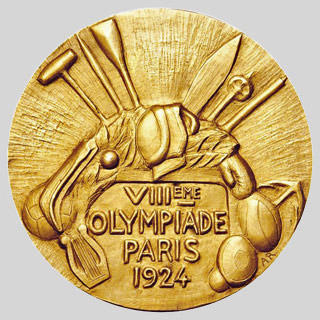
| 1st Place: | Gold Medal | Material: | Gilt Silver |
|---|---|---|---|
| Weight | 77 gr | ||
| 2nd Place: | Silver Medal | Material: | Silver |
| Weight | 76 gr | ||
| 3rd Place: | Bronze Medal | Material: | Bronze |
| Weight | 70 gr | ||
| Diameter: | 55 mm | Design by: | André Rivaud |
| Mint: | Paris Mint | ||
| Thickness: | 3 mm | Ribbon: | None |
| Obverse: | Winning athlete helping fallen athlete. | ||
| Reverse: | Sport equipment around legend. | ||
| Numbers of Medals: | Gold: 304 Silver: 304 Bronze: 304 | ||
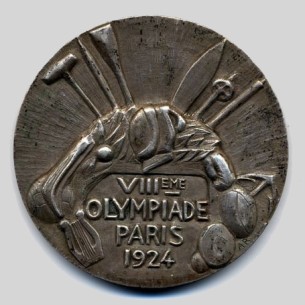
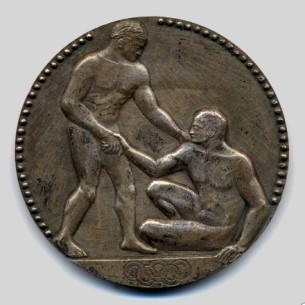
 1 1 winner and the sports engraved (great nephew of Ellis E. Jacob) |
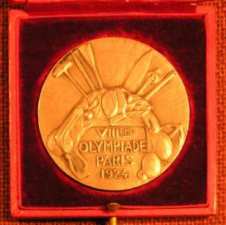 2
2Presentation case
|
| Competition for the Olympic Medal
The general rules of the Games specify that the Olympic Games prizes consist of both Olympic medals and certificates. Each medal is accompanied by a certificate. A certificate is also awarded to the winning team in team events. The Organizing Committee can, on the request of an international federation, award a certificate of merit to a competitor whose performance is outstanding, but who fails to win a prize. All participants in the Games receive a commemorative
medal. In team events, all those having effectively participated in the event have a right to a medal and certificate corresponding to prize won by the team. Moreover, at its session of 6th June 1921, in Lausanne, the international Olympic Committee decided, at the proposal from M. le Comte de Baillet-Latour, that an international competition be inaugurated by the French Olympic Committee and that the winning medal be put forward for the agreement of the International Olympic Committee, to become the definitive prize for future Olympic Games. Only the commemorative medal would be left to the choice of the national committees, so changing every four years. As the design of the Olympic medal had to be drawn up in order to be taken to the session of the International Olympic Committee in Rome in April 1923, it appeared impossible to assemble an international competition of far-flung artists, allowing them enough time to finish their work. So it was decided at the session of 9th June 1922 to cancel the international aspect of the competition 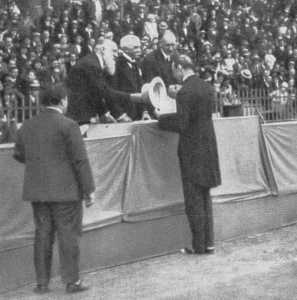 The victory ceremony with Pierre de Coubertin, 1924 Limited competition - So the French Olympic Committee was still responsible for organizing a competition restricted to young French artists of the Committee's choosing. A list of six names were given to the Committee by M. Olivier Sainsere, Président du Jury de Peinture (President of the Board of Painting Judges), a reputed lover of art, and M. Georges Salles of the Direction des Beaux-Arts (Director of Fine Art). They were Messrs Bénard, Fraisse, Morlon, Poisson, Rivaud, and Roques, all holders of gold medals or of the Prix de Rome (French government art scholarships) and all, moreover, practitioners of sport. They were informed in a letter dated 23 October 1922 of the rules of the competition. They had to take their work, on 1st February 1923, executed in plaster or in the definitive material, to the headquarters of the French Olympic Committee, to submit them to examination by the Commission des Arts. As the uncertainty of the reward, the fear of losing, and the time and effort involved made most of the artists taking part only devote their spare time to it, the members of the Commission decided that each of the candidates should receive 3,000 francs compensation for their work and the best judged design would achieve a 15,000 franc prize, with its creator commissioned to execute designs for the obverse and reverse faces of the medal. At the request of the French Olympic Committee, M. le Colonel Bonvalot, Directeur de l'Ecole de Gymnastique de Joinville (Director of the Joinville Gymnastic School) granted the artists authorization to attend athletes' practice sessions to use them as models if they wished to do so. Moreover, he arranged movie sessions for them, showing the Finnish winners of the preceding Games. In slow motion, they could study their stances and movements. However, when on 1st February the designs were taken to the session of the French Olympic Committee, one could be persuaded at first glance how difficult it is for an artist to shed the influences of the school to express freely direct impressions of life. Their work was conscientious, but clearly more or less inspired by antiquated influences The medal that appeared the most original was that of M. Rivaud. It was accepted by the Commission des Arts at the third round of judging. During the same session, the Commission decided to entrust the commemorative medal to M. Roques; but, because of the failure of this artist, the completion of his work was entrusted to M Raoul Benard, who had previously engraved the Winter Sports medal. The medals were struck at the Paris mint. (Source document: Official Report 1924, page 802) translated from the French original by John E. Harris, 2005) |